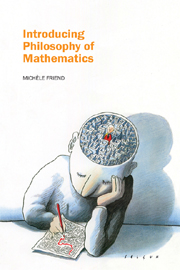2 - Mathematical Platonism and realism
Summary
Introduction
Together with Chapter 1, this is a lynchpin chapter in this book. Most positions in the philosophy of mathematics can be cast as reactions to Platonism. Some of them, such as logicism or some forms of structuralism, are modifications of Platonism; some, such as constructivism, are very strong reactions to it. It is important to study this chapter well, and have a solid grasp of realism by the end of it.
Section 2 will discuss Plato, since he is the originator of the realist position in the philosophy of mathematics. In §3 we then turn to realism more generally, as the modern incarnation of Platonism. We shall then look at two important modern defenders of realism: Kurt Gödel (§4) and Penelope Maddy (§5). We then discuss some very important problems with the views defended by both Gödel and Maddy, in different ways and to different degrees. Section 6 on the problems with set-theoretic realism motivates the rest of the book.
Historical origins
Unsurprisingly, mathematical Platonism originated with Plato (c. 427–c. 347 bce). Plato was interested in what mathematical truth consists in. He was exposed to geometry and arithmetic, so he was interested in what secures geometrical and arithmetical truths.
Plato observed that we grasp geometrical theorems in a way that is quite different from the way in which we grasp empirical truths, which are truths we arrive at using our senses. To learn mathematics we need neither have much sense experience nor be taught particular formulas, in the sense of memorizing them. It is enough for us to learn a few general principles, and we can piece together what we need to solve particular problems. In other words we seem to be able to reason a priori about geometry and arithmetic.
- Type
- Chapter
- Information
- Introducing Philosophy of Mathematics , pp. 23 - 48Publisher: Acumen PublishingPrint publication year: 2007



